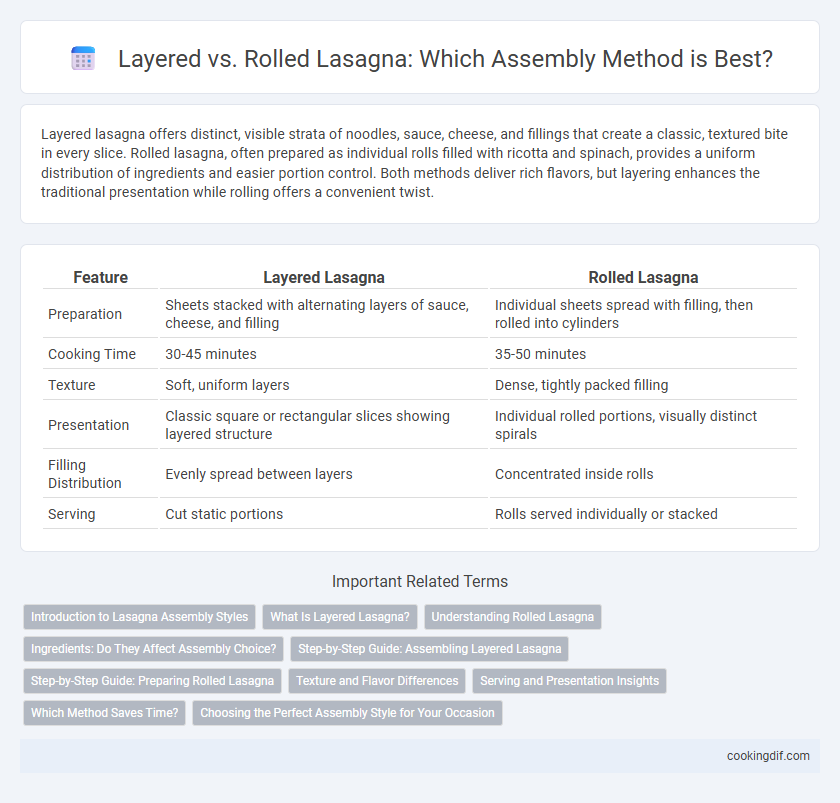Layered lasagna offers distinct, visible strata of noodles, sauce, cheese, and fillings that create a classic, textured bite in every slice. Rolled lasagna, often prepared as individual rolls filled with ricotta and spinach, provides a uniform distribution of ingredients and easier portion control. Both methods deliver rich flavors, but layering enhances the traditional presentation while rolling offers a convenient twist.
Table of Comparison
| Feature | Layered Lasagna | Rolled Lasagna |
|---|---|---|
| Preparation | Sheets stacked with alternating layers of sauce, cheese, and filling | Individual sheets spread with filling, then rolled into cylinders |
| Cooking Time | 30-45 minutes | 35-50 minutes |
| Texture | Soft, uniform layers | Dense, tightly packed filling |
| Presentation | Classic square or rectangular slices showing layered structure | Individual rolled portions, visually distinct spirals |
| Filling Distribution | Evenly spread between layers | Concentrated inside rolls |
| Serving | Cut static portions | Rolls served individually or stacked |
Introduction to Lasagna Assembly Styles
Layered lasagna features wide, flat pasta sheets stacked with alternating layers of sauce, cheese, and fillings, creating a classic, structured presentation. Rolled lasagna involves wrapping fillings inside individual pasta sheets, resulting in more uniform portions and a different texture experience. Both assembly styles highlight distinct visual appeal and influence cooking time, moisture retention, and flavor distribution.
What Is Layered Lasagna?
Layered lasagna consists of wide, flat pasta sheets stacked alternately with layers of sauce, cheese, and fillings such as meat or vegetables. This method creates distinct, visible strata that hold their shape when baked, offering a balanced texture and flavor in each bite. Unlike rolled lasagna, layered assembly emphasizes uniform thickness and easy portioning.
Understanding Rolled Lasagna
Rolled lasagna features individual pasta sheets filled with layers of cheese, sauce, and meat or vegetables, then tightly rolled before baking, offering a uniform distribution of ingredients in every bite. This method contrasts with traditional layered lasagna, where alternating sheets and fillings create distinct strata, resulting in varied textures per slice. Understanding rolled lasagna emphasizes ease of portioning and consistent flavor profiles, making it a practical alternative to the classic layered assembly.
Ingredients: Do They Affect Assembly Choice?
Lasagna recipes with chunky ingredients like large meat chunks or vegetables often favor layered assembly to evenly distribute fillings and maintain structure. Thinly sliced or ground ingredients suit rolled lasagna, allowing smooth, compact rolls that hold shape during baking. Ingredient texture and moisture levels directly influence whether layering or rolling yields optimal texture and flavor consistency.
Step-by-Step Guide: Assembling Layered Lasagna
Layered lasagna assembly begins with spreading a thin layer of sauce at the bottom of the baking dish to prevent sticking, followed by alternating layers of cooked lasagna noodles, ricotta cheese mixture, meat sauce, and shredded mozzarella. Each layer is assembled evenly to ensure balanced flavor and texture, typically repeating two to three times before topping with a final layer of noodles, sauce, and cheese. Baking the assembled dish at 375degF for 45 minutes seals the layers, creating a cohesive, hearty casserole with a golden, bubbling cheese crust.
Step-by-Step Guide: Preparing Rolled Lasagna
Preparing rolled lasagna involves laying out individual pasta sheets, adding a layer of filling such as rich ricotta and seasoned meat, then carefully rolling each sheet into a cylinder before placing them seam-side down in the baking dish. This technique requires evenly spreading the ingredients to ensure consistent flavor and texture in every bite. Rolling lasagna creates a visually appealing presentation while maintaining distinct layers of sauce, cheese, and pasta throughout each roll.
Texture and Flavor Differences
Layered lasagna offers distinct textural contrasts with tender pasta sheets alternating with creamy bechamel, savory meat sauce, and melted cheese, creating a harmonious bite in every forkful. Rolled lasagna enhances flavor intensity by tightly encasing fillings like ricotta, spinach, or meat inside each pasta strip, resulting in concentrated bursts of taste and a more cohesive texture. The choice between layered and rolled assembly impacts moisture distribution, with layered lasagna yielding a moister dish and rolled providing firmer, more structured servings.
Serving and Presentation Insights
Layered lasagna offers a classic presentation with visible, distinct strata of pasta, sauce, and cheese, enhancing visual appeal when sliced for serving. Rolled lasagna creates a uniform, elegant look, ideal for individual portions that emphasize texture and flavor balance in each bite. Choosing layered or rolled assembly affects not only serving ease but also how the dish's ingredients are highlighted on the plate.
Which Method Saves Time?
Layered lasagna assembly typically saves time compared to rolled lasagna since it requires simply stacking pre-cooked or no-boil noodles with sauce, cheese, and fillings in a baking dish. Rolled lasagna involves individually spreading filling over each noodle and rolling them up, which is more time-consuming and labor-intensive. For quick preparation without compromising flavor, layering remains the most efficient method.
Choosing the Perfect Assembly Style for Your Occasion
Layered lasagna offers a classic, visually appealing presentation ideal for formal dinners and family gatherings, providing distinct, sturdy portions that hold well on a plate. Rolled lasagna, with its compact, individually wrapped servings, suits casual events or buffet-style meals where easy handling and portion control are priorities. Selecting between layered and rolled assembly depends on the event's formality, serving style, and desired portion presentation.
Layered vs Rolled for assembly Infographic

 cookingdif.com
cookingdif.com